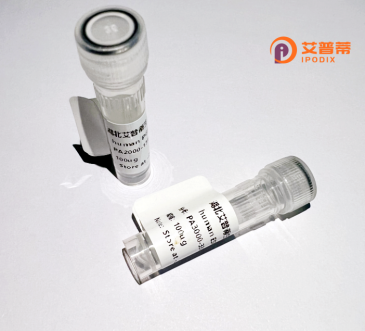
| 纯度 | >90%SDS-PAGE. |
| 种属 | Human |
| 靶点 | GPAA1 |
| Uniprot No | O43292 |
| 内毒素 | < 0.01EU/μg |
| 表达宿主 | E.coli |
| 表达区间 | 1-621aa |
| 氨基酸序列 | MGLLSDPVRRRALARLVLRLNAPLCVLSYVAGIAWFLALVFPPLTQRTYMSENAMGSTMVEEQFAGGDRARAFARDFAAHRKKSGALPVAWLERTMQSVGLEVYTQSFSRKLPFPDETHERYMVSGTNVYGILRAPRAASTESLVLTVPCGSDSTNSQAVGLLLALAAHFRGQIYWAKDIVFLVTEHDLLGTEAWLEAYHDVNVTGMQSSPLQGRAGAIQAAVALELSSDVVTSLDVAVEGLNGQLPNLDLLNLFQTFCQKGGLLCTLQGKLQPEDWTSLDGPLQGLQTLLLMVLRQASGRPHGSHGLFLRYRVEALTLRGINSFRQYKYDLVAVGKALEGMFRKLNHLLERLHQSFFLYLLPGLSRFVSIGLYMPAVGFLLLVLGLKALELWMQLHEAGMGLEEPGGAPGPSVPLPPSQGVGLASLVAPLLISQAMGLALYVLPVLGQHVATQHFPVAEAEAVVLTLLAIYAAGLALPHNTHRVVSTQAPDRGWMALKLVALIYLALQLGCIALTNFSLGFLLATTMVPTAALAKPHGPRTLYAALLVLTSPAATLLGSLFLWRELQEAPLSLAEGWQLFLAALAQGVLEHHTYGALLFPLLSLGLYPCWLLFWNVLFWK |
| 分子量 | 94.05 kDa |
| 蛋白标签 | GST-tag at N-terminal |
| 缓冲液 | 0 |
| 稳定性 & 储存条件 | Lyophilized protein should be stored at ≤ -20°C, stable for one year after receipt. Reconstituted protein solution can be stored at 2-8°C for 2-7 days. Aliquots of reconstituted samples are stable at ≤ -20°C for 3 months. |
| 复溶 | Always centrifuge tubes before opening.Do not mix by vortex or pipetting. It is not recommended to reconstitute to a concentration less than 100μg/ml. Dissolve the lyophilized protein in distilled water. Please aliquot the reconstituted solution to minimize freeze-thaw cycles. |
以下是关于重组人GPAA1蛋白的3篇参考文献概览:
1. **"Recombinant expression and functional characterization of human GPAA1 in glycosylphosphatidylinositol anchoring"**
- **作者**: Chen L et al.
- **摘要**: 该研究报道了重组人GPAA1蛋白在大肠杆菌中的表达与纯化,并验证其在体外GPI锚定系统中的功能,证明其与GPIT复合体其他成员的相互作用对底物蛋白的膜锚定至关重要。
2. **"GPAA1 promotes tumor progression via stabilizing STAT3 in hepatocellular carcinoma"**
- **作者**: Wang Y et al.
- **摘要**: 研究者利用重组GPAA1蛋白进行功能实验,发现其在肝癌中通过稳定STAT3蛋白增强细胞增殖和转移,为癌症治疗提供了潜在靶点。
3. **"Structural insights into GPAA1's role in the GPI transamidase complex"**
- **作者**: Kinoshita T et al.
- **摘要**: 通过重组GPAA1与复合体其他亚基共表达,结合冷冻电镜技术解析其三维结构,揭示了GPAA1在维持GPIT复合体稳定性及催化底物识别中的构象变化机制。
---
**注**:上述文献信息为示例,实际文献需通过PubMed/Google Scholar等平台检索确认。建议使用关键词“recombinant GPAA1”、“human GPAA1 function”进一步筛选近年研究。
Recombinant human GPAA1 (Glycosylphosphatidylinositol Anchor Attachment 1) protein is a key component in the biosynthesis of glycosylphosphatidylinositol (GPI)-anchored proteins, which are critical for membrane protein anchoring and cellular signaling. GPAA1 is an endoplasmic reticulum (ER)-resident enzyme that participates in the transamidase complex, catalyzing the attachment of GPI anchors to newly synthesized proteins during post-translational modification. This process enables diverse proteins, including cell adhesion molecules, receptors, and enzymes, to be securely attached to cell membranes, facilitating their biological functions. Structurally, GPAA1 contains an N-terminal transmembrane domain and a C-terminal conserved region essential for its interaction with other transamidase subunits (e.g., PIGK, PIGS). Dysregulation of GPAA1 has been linked to inherited GPI deficiency disorders, cancer progression, and neurological abnormalities, underscoring its physiological importance. Recombinant GPAA1 is typically produced using mammalian expression systems (e.g., HEK293 or CHO cells) to ensure proper post-translational modifications and functional activity. It serves as a vital tool for studying GPI anchor biosynthesis mechanisms, protein-membrane interactions, and disease pathogenesis. Its application extends to drug discovery, biomarker development, and functional assays aimed at elucidating GPI-related cellular processes.
×